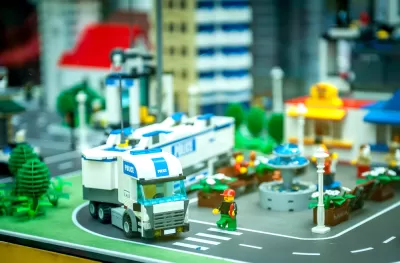A Dutch advocate believes Lego's city sets should reflect streets that prioritize all users. Including bike lanes would be one way for the toy manufacturer to start accomplishing that goal.

Andrew J. Hawkins reports on Lego's curious neglect of bikes: "The streets in Lego’s city sets had space for cars, trains, even tiny storm drains but no designated space for zero-emission, human-powered vehicles like bikes."
"Even worse," adds Hawkins, "it appeared that Lego’s streets were becoming more hostile toward pedestrians over time. As compared to Lego sets from years ago, the cars seem to have grown larger — evolving from four- to six-studs wide — and the roads appeared to be getting wider, while the sidewalks were getting more and more narrow."
A regional councilor from the Netherlands named Marcel Steeman has launched an advocacy campaign o move Lego toward more environmentally friendly representations of the world's built environment.
With the help of Marco te Brommelstroet, an associate professor in urban planning at the University of Amsterdam who tweets under the name Cycling Professor, Steeman submitted two designs to Lego’s “Ideas” project, in which fans are encouraged to submit proposals for new Lego sets. His proposal was simple: more bike lanes.
So far, the efforts has met roadblocks from Lego while winning attention online.

Maui's Vacation Rental Debate Turns Ugly
Verbal attacks, misinformation campaigns and fistfights plague a high-stakes debate to convert thousands of vacation rentals into long-term housing.

Planetizen Federal Action Tracker
A weekly monitor of how Trump’s orders and actions are impacting planners and planning in America.

In Urban Planning, AI Prompting Could be the New Design Thinking
Creativity has long been key to great urban design. What if we see AI as our new creative partner?

King County Supportive Housing Program Offers Hope for Unhoused Residents
The county is taking a ‘Housing First’ approach that prioritizes getting people into housing, then offering wraparound supportive services.

Researchers Use AI to Get Clearer Picture of US Housing
Analysts are using artificial intelligence to supercharge their research by allowing them to comb through data faster. Though these AI tools can be error prone, they save time and housing researchers are optimistic about the future.

Making Shared Micromobility More Inclusive
Cities and shared mobility system operators can do more to include people with disabilities in planning and operations, per a new report.
Urban Design for Planners 1: Software Tools
This six-course series explores essential urban design concepts using open source software and equips planners with the tools they need to participate fully in the urban design process.
Planning for Universal Design
Learn the tools for implementing Universal Design in planning regulations.
Appalachian Highlands Housing Partners
Gallatin County Department of Planning & Community Development
Heyer Gruel & Associates PA
Mpact (founded as Rail~Volution)
City of Camden Redevelopment Agency
City of Astoria
City of Portland
City of Laramie




























